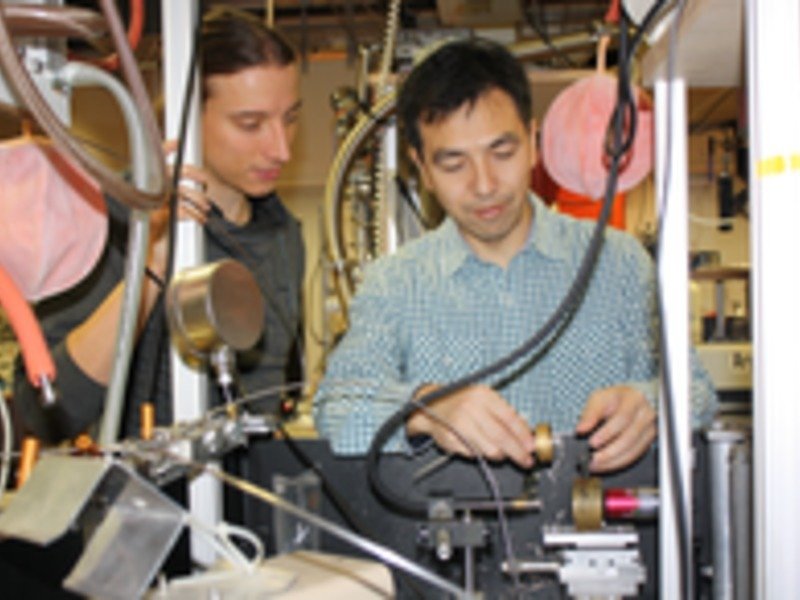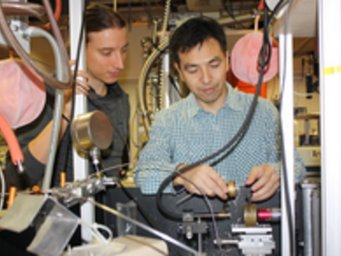Carbonic acid is stabilized by high pressure and high temperature
MPIC researchers ‘tame’ reactive molecule under high pressure – relevance to the Earth system might have been underestimated
Until now, little scientific attention has been lavished on the acid H2CO3, commonly known as carbonic acid. Although known to form when carbon dioxide dissolves in water, carbonic acid reacts in a fraction of a second to form the more stable bicarbonate ion (HCO3-), and therefore the concentration of the acid is so small under ambient conditions that it is usually disregarded in a geological context. However, recently researchers from the Max-Planck Institute for Chemistry in Mainz have developed a new method to investigate carbonic acid, and have discovered that it is stabilized by high pressure and high temperature. This means that carbonic acid becomes an important species to consider some 80 km below the Earth’s surface. Their study was recently published in the Open Access magazine “Scientific Reports” from Nature Publishing Group.

By means of a diamond anvil cell and a CO2 laser the researchers from Mainz simulated conditions found down to 300 km depth inside the Earth. At pressures up to 9.1 Gigapascal (GPa) and temperatures up to 1,200 °C (hotter than the surface of a volcano) they investigated the behavior of CO2 and H2O. The team, consisting of researchers from the Department of Atmospheric Chemistry and from the High Pressure Research Group guided by Mikhail Eremets, discovered something quite surprising: starting from a pressure of 2.4 GPa and temperatures in excess of 97 °C aqueous carbonic acid becomes stable.
“Initially we prepared a study on the reactivity of carbon-containing fluids with different ratios of hydrogen and oxygen inside Earth, i.e. under very high pressure”, Janek Zeuschner PhD student at the Max Planck Graduate Center explains the start of the study. To test the experimental setup with a related system they chose for one of best-known ones: CO2 and H2O.
At ambient temperature, water and carbon dioxide are solid under the pressures investigated. To promote chemical reaction and to create more realistic geological conditions where temperature increases with depth, the researchers heated the sample with a CO2 laser. To their amazement they discovered that crystals formed at pressures above 2.4 GPa in the diamond anvil cell. Janek Zeuschner was first to recognize the potential meaning of the Raman and Infra-Red spectra recorded from these samples: namely the formation of solid carbonic acid. “No previous study had given any indication that CO2 and H2O might form significant amounts of carbonic acid at high pressure”, Janek explains. Although further experiments showed that the initially formed crystals dissolved at lower temperatures in liquid water, stable molecules of carbonic acid remained in solution and were more abundant, the higher the solution was heated.
“At this point we realized that, contrary to commonly accepted understanding, carbonic acid could actually be a rather important molecule at depths of more than 80 km in the Earth. Indeed, inside the Earth we find exactly the conditions of our experiment: extremely high pressure and high temperatures”, Hongbo Wang from the High Pressure Research Group explains the results of the study.
The researchers have gone even further. When heating the sample with a laser, the sample matrix solidifies rapidly at the trailing end of the moving laser spot and thereby “freezes” the state the solution was in at high temperature. In this state there exists much more carbonic acid in solution than would be soluble in water at lower temperatures (i.e. close to the melting point of water at the pressure of the experiment). Because the excess carbonic acid is no longer stable in solution, the molecules precipitate in a solid form. The process of fast cooling at the trailing end of the laser spot causes water to freeze (due to the high pressure) before it can react with the precipitated carbonic acid. “We can now investigate solid carbonic acid at ambient temperature and even up to the melting point of water at the applied pressure, after laser heating our samples”, observed the chemist Janek Zeuschner.
The discovery could change the current understanding of physical properties of deep fluids (e.g. electric conductivity) which transport molecular carbonic acid. “That carbonic acid is a stable and a quantitatively significant substance inside the Earth impacts our understanding of the global carbon cycle”, summarizes Jonathan Williams, group leader in the Department of Atmospheric Chemistry, before adding “it could also influence chemical evolution within these fluids and thereby affect current subterranean theories on the origin of life.”
Additional Information:
Mikhail Eremets has previously used high pressure diamond anvil cells to great effect. In summer 2015 he published a study about the remarkable superconductivity of hydrogen sulfide (H2S) under high pressure at record temperatures of -70 °C (doi: 10.1038/nature14964). In 2011 he already discovered that hydrogen under pressure adopts metallic properties (doi: 10.1038/nmat3175).
